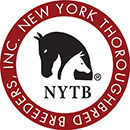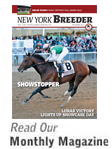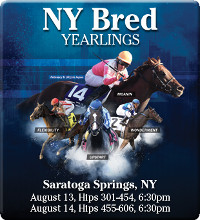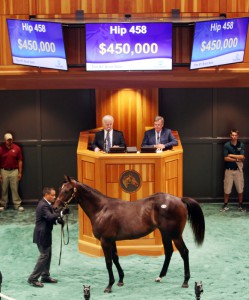A colt by hot young sire Uncle Mo brought a sales-record price of $450,000 to top an unusual renewal of the Fasig-Tipton New York-bred preferred yearling sale. Slated to occupy two sessions on Saturday and Sunday, the sale’s Saturday session was cancelled after only two horses went through the ring due to violent storms. The auction was rescheduled for Sunday, when the full catalog was offered in a single session beginning at 3 p.m.
The $450,000 Uncle Mo colt, Hip 458, who is currently named Mo Diddley, was purchased by Everett Dobson of Cheyenne Stables from the consignment of McMahon of Saratoga Thoroughbreds LLC, Agent. Bred by Andy Beadnell, the colt is the fifth foal out of Miss Bodine, a Kentucky-bred stakes-placed daughter of Vindication, whose first two foals (and only two to start) are winners. Most recently her second foal, 4-year-old Euros to Dollars, picked up his second career victory in a Saratoga allowance on August 6.
Miss Bodine is a half sister to ten winners including three stakes winners: Icecoldbeeratreds (In Excess [IRE]), winner of the Grade 2 Del Mar Futurity, and his full siblings Controlled, who is also a multiple stakes producer, and Inexcessive Speed. Currently Miss Bodine has a weanling colt by Mucho Macho Man.
Dobson told the TDN “I liked his presence. Obviously Uncle Mo is maybe the most exciting young stallion we’ve had in this sport in many, many years. And it’s a New York-bred. I like that. I race up here a lot. He checked all the boxes and I’ll be glad to put him in the racing stable – thrilled to put him in the racing stable.” Dobson said the colt will go to Randy Bradshaw in Florida for early training, but has not decided who will train him at the track.
Breeder Andy Beadnell commented, “We knew he was going to sell well, but we didn’t know he’d go that high. [Consignor] Joe [McMahon] knew. He knew who was on him and he put the reserve higher than what I was kind of happy with, but it worked. He went way past his reserve.”
Next in the rankings of the top sellers were a pair of colts purchased by Linda Rice on behalf of Sheila Rosenblum (of La Verdad fame). The pair were also under bidders on the sale topper.
Hip 385, a bay colt by City Zip bred by John Lauriello, sold from the Indian Creek consignment for $375,000. The City Zip colt is the first foal out of Flaunted, an unraced Tale of the Cat mare. Flaunted is a half sister to stakes winner Lady Melesi, who is also a multiple stakes producer.
Rice, who trained City Zip and is always on the lookout for likely offspring of his, said, “City Zip has had an incredible year. This horse is a City Zip that looks like he’ll get two turns – he’s really a stretchy horse. He’s a New York-bred and I think he’ll run long.”
Rosenblum commented, “We looked at quite a few and he definitely stood out, with his conformation and the way he walked. We are looking for two-turn horses. Ideally for a colt that is distance, dirt or turf, or a filly with a decent pedigree. And New York-breds are very good for us since we’re both in New York. These City Zips are really proving themselves.”
The second major purchase by team Rice-Rosenblum and third top-seller was Hip 490, a son of Mineshaft who is a half-brother to New York-bred graded stakes winner and classic contender Upstart ($1,732,780). The colt brought $335,000 from the Summerfield consignment.
Bred, like Upstart, by Mrs. Gerald A. Nielsen, the colt is out of Party Silks, an unraced daughter of Touch Gold also bred by Mrs. Nielsen. The mare has produced two winners from two starters, and was bred this year to American Pharoah. The sale colt’s second dam Intend to Win (Housebuster) is a stakes-placed Kentucky-bred purchased by Gerald Nielsen for $120,000 at the 2001 Keeneland November sale.
Rice commented, “I picked out three colts here. The City Zip colt, the [sale-topping] Uncle Mo colt that we were the under bidder on and let go, and this one. So we were a little sad about the Uncle Mo colt, but we got this one.”
Overall sale indicators did not quite rise to the lofty and record-breaking heights of 2015, but were strong, nevertheless, and fully in keeping with the gains made by the New York-bred program the last five years. The results were also in keeping with the current auction trend toward strength at the high end of the market and more difficulty at the low.
Of 263 yearlings offered, 177 sold (including 16 private sales). The sale average of $77,246 dipped 5.5% from last year’s record-setting $81,739, while the median of $60,000 was down 7.7% from a record-tying $65,000 in 2015. The buyback percentage was 32.7% compared with 27.8% in 2015. A total of 43 yearlings sold for at least six figures, with nine fetching $200,000 and up.
Fasig-Tipton President and CEO Boyd Browning, Jr. told the TDN, “I think it was a pretty similar marketplace to last year. It might be a tiny bit tighter. We saw slight declines, not alarming declines, but slight declines. If you are in the upper echelon of the catalogue, whatever catalogue it happens to be, you’re going to be in really good shape and there is plenty of activity.”
Continued Browning, “Bunches and bunches of horses sold way above their reserves in that echelon. But when you are in the bottom half of the catalogue at a sale like this, it is hand-to-hand combat. It’s tough and you better know who you have on your horse and you better hope you have someone on your horse. The perceived less-quality horses are difficult to sell. That hasn’t changed at all in recent years and rather than narrowing the definition of what is not perceived quality, that definition might be expanding slightly.”
Brown, who did not think the single-session format had an impact on sale results, also felt that the buyback percentage was in line with recent sale history. He believes it continues to reflect the attractiveness of racing in New York as an option for breeders who do not get the prices they are seeking in the auction ring.
Said Browning, “Historically, if you do a chart for this sale over the last 10 years, this is basically right in range with the traditional buy-back rate. The beauty and the curse of a New York-bred is that they have the ability to run for significant purse dollars. Those earnings potentials apply to breeders as well as to buyers. And the breeders probably have a greater tendency to retain their horse because they can control where it races. If you are a New York breeder and you buy your horse back, it’s going to run in New York in virtually all instances.”











